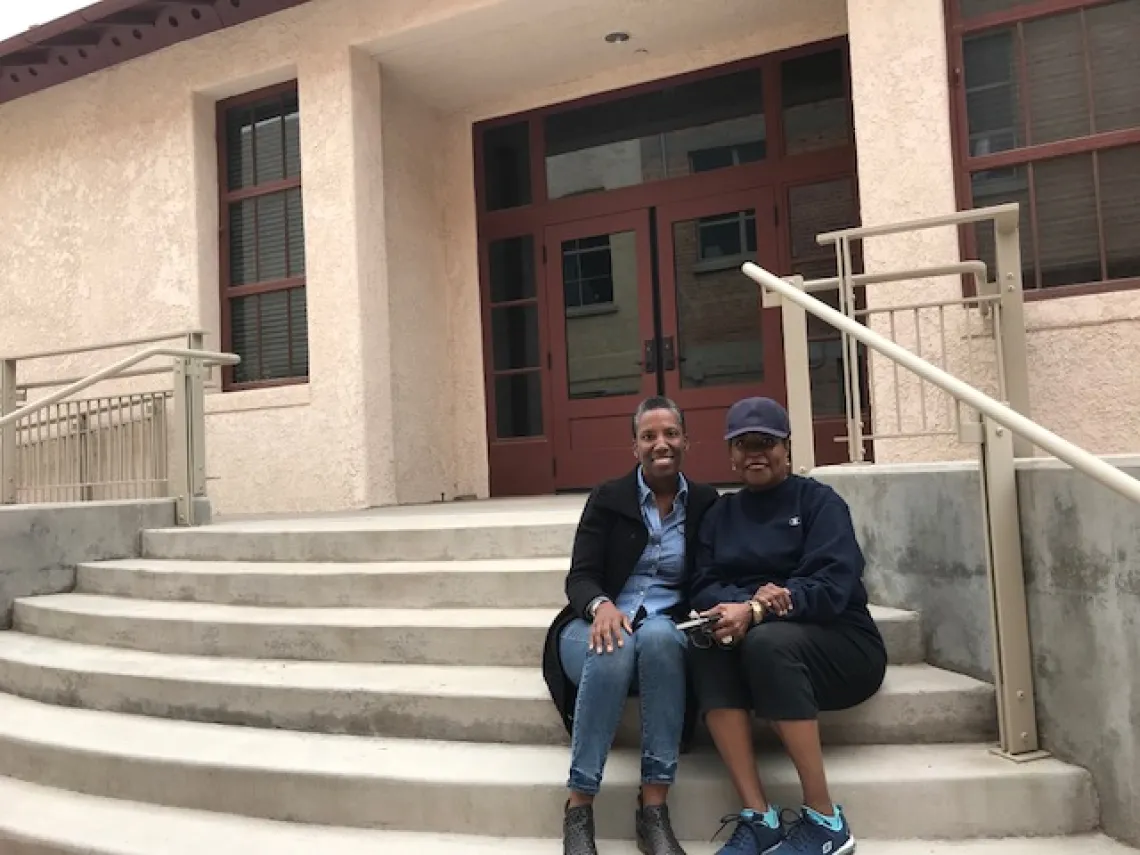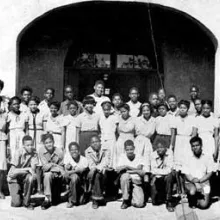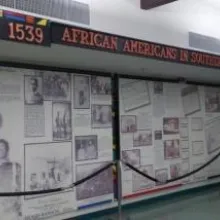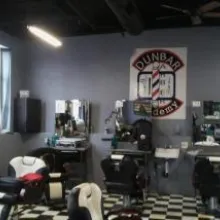UA Community Impact Fellow to Animate Tucson's Dunbar Pavilion

Debi Chess Mabie and Chyrl Lander on the steps of the Dunbar Pavilion. They want the Pavilion to be a gathering place for diverse voices and cultures and to increase the understanding of the historic and cultural impact of people of African descent.
On a Friday morning, the Dunbar Pavilion – commonly known as the Dunbar School – sits quiet except for the lively Dunbar Barber Academy, which operates out of a second-floor room that housed a Home Economics class some 40 years earlier. The hallways of the building have signs and photos that reflect the building’s history as the first and only segregated school in Tucson. Some of the classrooms look shiny and new, ready to welcome inhabitants. Others are worn, with chipped paint and exposed ceilings. There is work to be done here, work to complete the renovation of the space and to fill the rooms with a vibrancy that honors the building’s history and helps further shape the story of the African American experience in Tucson. Debi Chess Mabie has been hired by the University of Arizona College of Social and Behavioral Sciences and the Dunbar Coalition to do that work.
Mabie looks focused and determined. She left her job as executive director of the Arts Foundation for Tucson and Southern Arizona to become the college’s first Community Impact Fellow, which is affiliated with the Southwest Folklife Alliance and co-funded by the College of SBS and the Dunbar Coalition for a two-year commitment. The Dunbar Coalition is the governing body of the Dunbar Pavilion and includes representatives from Dunbar alumni, the Tucson Urban League, the Juneteenth Festival committee, and the Dunbar/Spring Neighborhood Association.
Mabie’s task is to help lead the Dunbar Pavilion: An African American Arts and Culture Center – located on 325 W. 2nd Street – into its next 100 years of cultural significance.
“The Dunbar is one of the last remaining physical representations of the African American community here in Tucson,” Mabie said. “What we are doing will not only support and promote the accomplishments of African Americans, but create opportunities to reverse the effects of segregation in this community.”
The Dunbar History

The construction of the Dunbar School was completed in January 1918. The school – named after Paul Laurence Dunbar, a renowned African American poet – educated Tucson's African American students in the first through ninth grades until 1951, when segregation was eliminated from the school systems of Arizona. The Dunbar School then became the non-segregated John Spring Junior High School until 1978 when the school was closed permanently.
Chyrl Hill Lander, a member of the Dunbar Coalition, said that the Coalition purchased the building from Tucson Unified School District in 1995 for $25, with the goal of converting it into an African American museum and cultural center.
Members of the Coalition worked with former Congressman Jim Kolbe and Congressman Rául Grijalva to secure federal funds to renovate the space, including the auditorium and three-quarters of the classrooms. Lander adds that the Coalition continues talking with Griljalva to secure the funds needed to complete the renovations.
Grijalva is a big supporter of Dunbar, Lander said, as well as Mayor Jonathan Rothschild, the Tucson City Council, and the Pima County Board of Supervisors: "We are thankful for the support we've received from all of our elected officials.”
Currently, the two main tenants of the Dunbar Pavilion are the Dunbar Barber Academy and the Barbea Williams Dance Academy Company. Tucson’s Black Film Club also screens movies at the Dunbar Pavilion every three months. These activities, in addition to rental of the auditorium and commercial kitchen, provide the main sources of revenue for the building.
Dedicated volunteers have kept the Pavilion running but have not been able to provide the continuity to grow the Pavilion into the significant cultural and economic development asset that the Coalition envisions.
An Exciting Future
Mabie wants all 60,000 square feet of the Dunbar Pavilion to be “animated.”
“For such a large piece of property not to be used is a shame,” Mabie said. “We have so much potential here.”

Mabie, in partnership with the Coalition, will focus on developing partnerships and involving community, business, and civic leaders in the evolution of the project. She will supervise the fundraising, programming, and revenue development activities that are critical to the mission of the center.
Mabie wants to create a space where different organizations share the facility and resources. She is looking for groups whose goals aligns with the five pillars of the Pavilion’s mission: health and well-being; education; art and culture; economic development and entrepreneurship; and civic engagement.
Even as the space is rented to various community groups, it is essential that the historical significance of the space be apparent.
“When you walk in, you should know what this space is about,” Mabie said. “You should know that school segregation created an environment where many African Americans thrived despite inequities. This was the heart and soul of the community for so many years.”
Lander says they are looking for a community partner to help them develop one of the rooms as a museum to house artifacts and memorabilia that document the contributions African Americans made to the development of the Southwest.
UA students may also become involved in this revitalization, perhaps by helping execute the strategic plan or by supporting the Dunbar/Spring community garden through the UA Community and School Garden Program.

Mabie has the experience and the drive to take on this work. She has over 25 years of nonprofit program development and leadership experience in a variety of sectors – including arts-based economic development and youth and community development. Prior to moving to Tucson in 2010, she was the executive director of BooCoo Cultural Center and Café in Evanston, Illinois. She was the development director of The Loft Cinema before her most recent position with the Arts Foundation for Tucson and Southern Arizona. Mabie is also the chair of the Tucson Black Film Club and a board member of the Non-Profit Loan Fund and TedEx Tucson.
“Debi is the ideal person to make this grand experiment work,” said Monica J. Casper, associate dean for faculty affairs and inclusion for the College of Social and Behavioral Sciences. “She has strong roots in the community, is a skilled administrator, is deeply committed to African American advancement, and understands the value of leveraging UA’s resources for good. She has already hit the ground running, and we anticipate great outcomes.”
Casper said she developed the idea of a Community Impact Fellow to deepen the college’s connections to the community. “The Fellow is the connective tissue, aligning our land-grant mission with the work of a partner organization.”
Casper explains that Mabie is working with the Southwest Folklife Alliance, an affiliate non-profit organization of the College of SBS, because of “that organization’s track record of building organizational capacity. The goal is to create capacity including all the necessities of Dunbar being self-sustaining within two years.
Lander said that the members of the Dunbar Coalition are thrilled that Mabie has been hired to help the Pavilion grow: “As we approach our 100 year anniversary celebration, we seem to be on a precipice. We needed a staff person here full time. Debi is a true asset and we are very pleased.”

